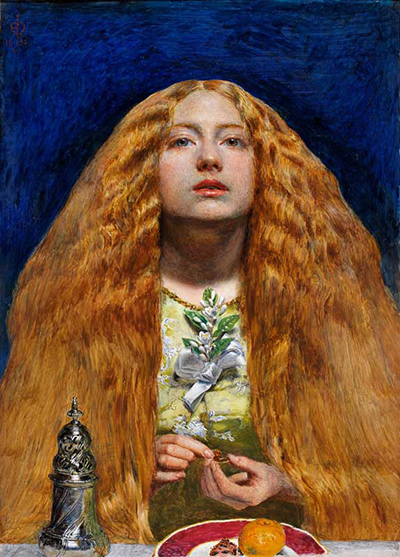The Bridesmaid was painted by Millais during his Pre-Raphaelite period as the artist began to move away from directly imitating medieval art. During this time, Millais and fellow Pre-Raphaelite Hunt focused on realist and scientific aspects of movement.
The artist eventually abandoned Pre-Raphaelitism in 1860, when he adopted a looser style influenced by Sir Joshua Reynolds. Reynolds had been an early foe of the Pre-Raphaelites, who criticised the lax style of the influential artist and founder of the Royal Academy of Arts. Artists influenced by Millais included James Archer and Joseph Noel Paton.
Painted in 1851, ‘The Bridesmaid’ illustrates one of many Victorian marriage traditions. Victorians believed a bridesmaid would see a vision of her true love if she passed a piece of wedding cake through a ring nine times, a ritual depicted in Millais' painting. This is not the only symbolism found in the painting. An orange blossom on the woman’s chest represents chastity.
There is also a hint of fear in the woman's face, giving the sense that the bridesmaid is thinking about her future. More recent students of Millais' paintings point to hidden sexual images, and in 'The Bridesmaid' a phallic-shaped sugar caster may represent the woman's future lover. The object disrupts the piece’s symmetrical composition, drawing the viewer’s attention to it.
‘The Bridesmaid’ also shows Millais’ tendency to depict women with long hair. Like female subjects in ‘Mariana’ and ‘Ophelia’ as well as ‘Esther’ (1865) and ‘The Martyr of the Solway’ (c. 1871), the bridesmaid has a longing and dreamy look. Millais also tended to illustrate women alone and looking uneasy, like in 'The Bridesmaid'.
After abandoning Pre-Raphaelite principles, Millais’ later work was broader in style. In addition to being influenced by Reynolds, his art also paid tribute to Old Masters like Velázquez and Rembrandt.
They were also influenced by English painters James Abbott Whistler and Albert Moore. His paintings drew on historical themes, including ‘The Two princes Edward and Richard in the Tower’ (1878), ‘The Northwest Passage’ (1874), and ‘Boyhood of Raleigh’ (1871).
In 1885, Queen Victoria named Millais a Baronet and a year later he was elected as the president of the Royal Academy of Arts. In 1896, Millais died of throat cancer and was buried at St. Paul’s Cathedral in London. The original of ‘The Bridesmaid’, an oil on panel painting, is found at the Fitzwilliam Museum in Cambridge.
John Everett Millais was a painter and illustrator known as a founder of the Pre-Raphaelite Brotherhood with William Holman Hunt and Dante Gabriel Rossetti. Founded in 1848, the Pre-Raphaelites was a group of English artists and critics. Other members included William Michael Rossetti, James Collinson, Frederic George Stephens and Thomas Woolner. The movement rejected Mannerist artists that followed Raphael and Michelangelo as well as Classical poses and compositions. The group was heavily influenced by Romanticism and medieval culture.
Born in 1829, Millais spent his early childhood in Jersey and was encouraged to pursue the arts by his mother. At the age of 11, he was enrolled in the Royal Academy of Art. It was at the school that Millais met Hunt and Rossetti and formed the Pre-Raphaelite Brotherhood at his home on Gower Street in London.
Millais’ Pre-Raphaelite works included ‘Christ in the House of His Parents’ (1849-50), a controversial piece because of its realistic depiction of the Holy Family as working class carpenters. Other popular works included ‘A Huguenot’ (1851-52) and ‘Ophelia’ (1851-52). In 1850-51, Millais painted ‘Mariana’ based on William Shakespeare’s ‘Measure for Measure’ and poems by Tennyson. ‘Mariana’ shows a yearning figure, similar to ‘The Bridesmaid’.




